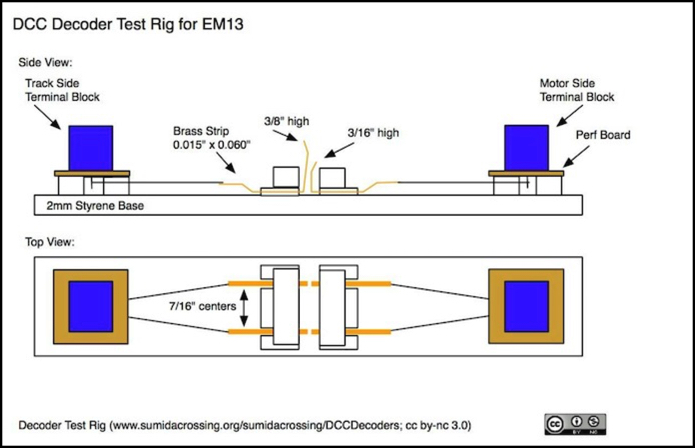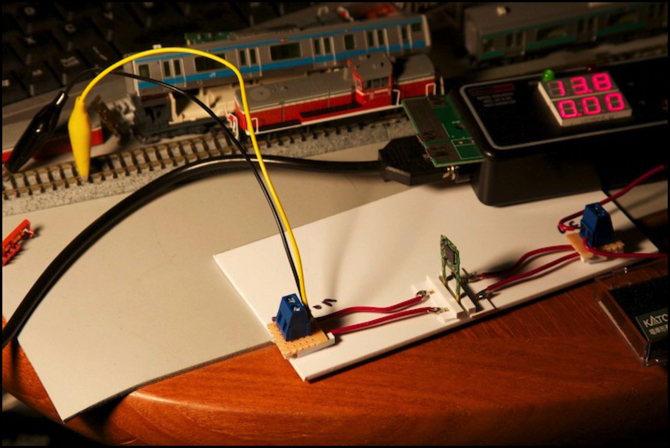Kato DCC Decoders and a Decoder Tester

No video yet, although I have been running trains. But now that I have some real working track, I’m even more motivated to get some of my trains converted to DCC (so far there’s just one, the Jōban E231 described on my Adding DCC and Lights page). So, back I go to the hell that is Kato “DCC Friendly” decoder installation. Really, the marketing person who thought that phrase up was truly evil. There’s nothing friendly about this process. DCC doesn’t have to be hard, but with Kato it all too often is.
The DCC Friendly trains are typically multiple-unit trains, where the motor is in a separate car from the head and tail lights, thus they need a minimum of three decoders: Two cab decoders (FL12) and a motor decoder (EM13). Each car has a socket for the decoder to slide into, with brass contact strips to supply power (taken from wheel-mounted pickups) and connect the output to the lights or motor. The problem is that these sockets are made from the train floor casting and loose strips of brass, and aren’t really up to Kato’s usual standard of quality, and frequently make poor contact. And when they don’t work, it’s really hard to figure out what’s wrong, and how to fix it. The above noted DCC and Lights page has a references section at the end linking to articles by others who have done this, where you may find more tips. I’ve also created a Decoder Testing page to provide some guidance.
But while I was working on my second train (and it’s proving a real headache, I still don’t have the EM13 working) I decided I needed a test rig so I could prove the EM13 worked, separate from a train. The Decoder Testing page has a longer explanation, but basically I made a simple socket out of styrene and some brass strips. One side hooks up to the DCC Command Station’s “Rail” outputs, the other to a length of track. I put a DC loco on the track, and if the decoder works, the train will move when the throttle is advanced (since the decoder outputs DC to the “motor” which goes to the track, where the loco picks it up just as if an ordinary throttle had provided it). This worked out well, and gave me a lot more confidence in my decoders, as well as proving that one really was busted (probably by me). I’m going to add a set of Stationary Rollers to the rig(although they’re sold out now, I got the last set and it’s on the way), so I can test various throttle speed settings using the rig.

An EM13 decoder in the test rig, and the red DE10 it’s driving
Just to note: the FR11 decoder for the interior lights, which works with the LED-based interior lighting kit, but not the bulb-based one, isn’t really needed. Without it, the lights will be always on, and rather bright, but this is apparently not enough to harm them (although it might be if your DCC Command Station had a very high output voltage, as some cheaper ones do).
When it works, the Kato system is pretty good. The three decoders add up to a bit more than a single integrated decoder would be, around US$50, but they do their job. You just program each one to the same address, and make sure the motor car is facing in the right direction so that it moves towards the end that has the headlights lit. And that’s another nice touch, the same decoder does both head and tail lights on the cab car, and can be inserted in either of two orientations. In one, the headlights are lit when the decoder is set to “forward”, in the other the tail lights are lit. And they swap when you change direction.
And they’re pretty good decoders. They support the full “4-digit” addressing (although it’s a bit quirky to set, see my Kato Decoder page noted above), back-EMF (to keep trains at a constant speed on dirty track or grades), supersonic operation (the power pulses to the motor can cause audible noise on cheap decoders) and support features like acceleration/deceleration and speed tables, as well as Digitrax’s proprietary “transponding” feature. I haven’t made much use of that, but now that I have a large loop of track and a long grade, I’m going to be doing a bit of fine-tuning once I get a few more installs done.
Finding a supplier can be hard. Kato USA does make these available in the U.S., but availability is spotty, and it’s not much better in the overseas hobby stores, which tend to sell out quickly whenever they get a new batch in. The best bet is probably to put in a reservation at one of the stores that allows this when a new batch is put up for reservation, although this will cost perhaps 20-30% more than buying domestically due to the strong yen and shipping costs. Right now, Hobby Search is taking reservations for an October batch of EM13 motor decoders, FL12 cab-light decoders and FR11 interior-light decoders. I’d suggest getting one or two more than you need just in case of any problems; if you’re serious enough about the hobby to do this once, you’ll eventually buy more trains and use any others.
Other website updates:
- Added a Train Photos photo album, for pictures of my trains running on the layout.
- Added photos to the Decoder and Diagrams photo albums.
- Added a bit to the end of the “phase 2i” construction page about the subway roof work.




